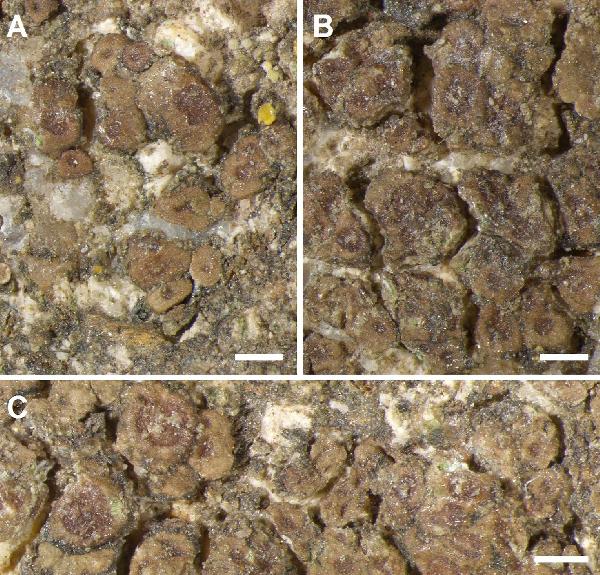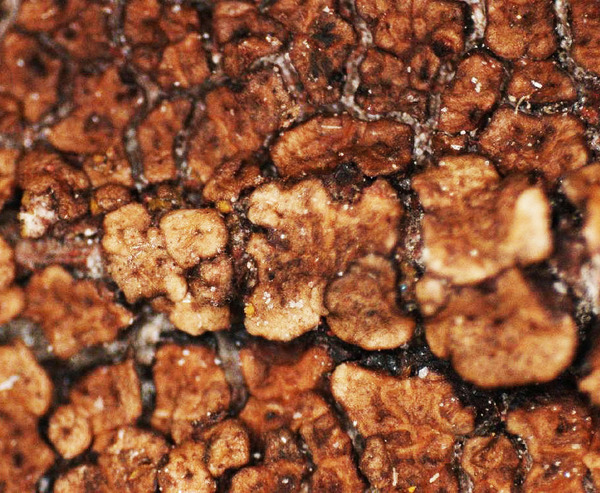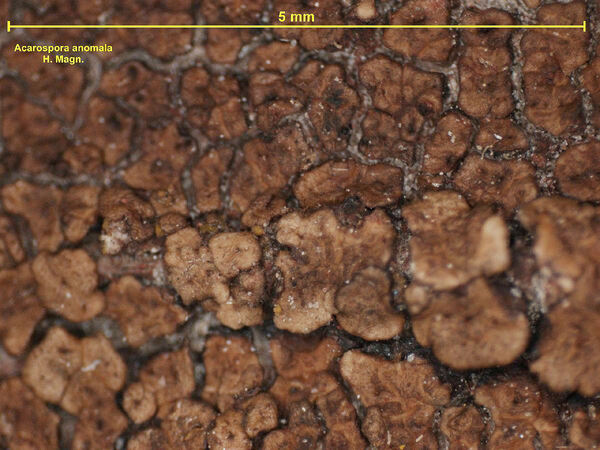Acarospora fusca B. de Lesd.
Rec. Lich. Dunkerque, 1, Suppl.: 100, 1914
Synonyms: Acarospora anomala H. Magn.
Distribution: N - TAA (Nascimbene & al. 2007b).
Description: Thallus crustose, episubstratic, minutely areolate, without a distinct prothallus, forming up to 1 cm wide patches. Areoles 0.2-0.9(-1.5) mm wide, 0,2.0,4 mm thick, contiguous, rounded to irregular, flat to usually slightly convex, deep brown to pale reddish brown, pale and ecorticate in lower part, epruinose. Epicortex lacking or <10 μm thick; cortex (10-)40-60 μm thick, the brown upper layer c. 10 μm thick, the lower layer colourless; algal layer 50-100 μm thick, even, continuous or rarely interrupted by <10 μm wide hyphal bundles, continuous beneath apothecia; medulla 100-250 μm thick, mixed with substrate particles. Apothecia lecanorine, 0.1-0.25(-0.6) mm across, rounded, 1-3(-4) per areole, immersed, with a reddish brown to dark brown, epruinose, usually flat, smooth or rough disc, and a usually paler brown, raised, smooth margin, the disc tending to become pseudogyrose when old. Proper exciple indistinct or expanding up to 60 μm around the disc, often forming an elevated margin concolorous with thallus; epithecium yellowish brown, c. 10 µm high; hymenium colourless, (85-)100-140(-160) µm high, the hymenial gel hemiamyloid, K/I+ light blue fading to light red; paraphyses 1-1.7 µm thick at mid-level, the apical cells cylindrical to clavate and up to 2.5 μm wide; subhymenium (20-)40-55 μm high, IKI+ blue; hypothecium 10-15 μm high. Asci 100-200-spored, clavate, the apical dome K/I-. Ascospores 1-celled, hyaline, narrowly ellipsoid to bacilliform, 3-5(-6) x (1-)1.5-1.7(-2) µm. Photobiont chlorococcoid. Spot tests: cortex and medulla K-, C-, KC-, P-, UV-. Chemistry: without lichen substances.Note: a poorly known species of eutrophicated, dry and hard lignum and siliceous rocks, hitherto reported from several localities in Northern and Central Europe. For further details see Knudsen & al. (2021, 2021b). A dubious record from Campania by Garofalo & al. (1999) is not accepted here.
Growth form: Crustose
Substrata: lignum
Photobiont: green algae other than Trentepohlia
Reproductive strategy: mainly sexual
Poorly known taxon in need of further study
Commonnes-rarity: (info)
Alpine belt: absent
Subalpine belt: extremely rare
Oromediterranean belt: absent
Montane belt: extremely rare
Submediterranean belt: absent
Padanian area: absent
Humid submediterranean belt: absent
Humid mediterranean belt: absent
Dry mediterranean belt: absent

Predictive model

Source: Knudsen et al. 2017, Mycotaxon 132: 861
Neotype of Acarospora fusca (Schiefelbein 4446, NY): A, dispersed areoles of the thallus with solitary apothecia. B, areoles with mostly solitary apothecia forming a contiguous indeterminate crust. C, apothecia 1–(2–4) per areole in contiguous crust. D, vertical section of ascoma. Scale bars: A–C = 500 μm; D = 100 μm. (Reproduced from Knudsen et al. 2017, Mycotaxon 132: 861).GZU). C. Detail of the thallus with sharp edged areoles and immersed apothecia. – Scale bars: A, B = 1mm. C =500 μm.
Growth form: Crustose
Substrata: lignum
Photobiont: green algae other than Trentepohlia
Reproductive strategy: mainly sexual
Poorly known taxon in need of further study
Commonnes-rarity: (info)
Alpine belt: absent
Subalpine belt: extremely rare
Oromediterranean belt: absent
Montane belt: extremely rare
Submediterranean belt: absent
Padanian area: absent
Humid submediterranean belt: absent
Humid mediterranean belt: absent
Dry mediterranean belt: absent

Predictive model

 Index Fungorum
Index Fungorum
 GBIF
GBIF



